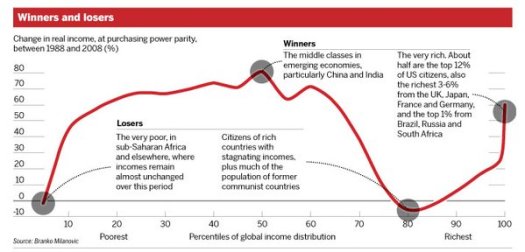Redeeming the losers of globalization
Multinational companies[1] worldwide earned gold money in the years 1980 – 2013. In 2013 their profit after tax reached $ 7200 billion, almost 10% of the gross national product of the world. Half of the 2013 profits belong to North American and West European corporations[2]. The tremendous increase in profits is a direct consequence of globalization: The expanding global trade of goods and services at ever-lower prices, made possible by global competition, automation, offshoring, and low cost of raw materials[3].

The question is who has benefited most from the increased wealth and who least? For many years the Serbian-American economist Branco Milanovic has focused on answering this question[4]. He divided the world population into 10 groups for 30 consecutive years: The poorest 10%, the second-poorest 10% and so on. He calculated the change in income for each of these groups within this period. The graph below depicts the outcomes. This graph is called the elephant curve because of the eye-catching similarity with the back of an elephant.

Worldwide, there are two groups of winners and two groups of losers.
The winners:
- The richest 5% of the world, the 1% richest in particular. Half of the benefits of economic growth went to this group. Fabulously wealthy people can be found in all countries. However the majority are living in North America and West Europe.
- The middle class within Asian countries. Its income increased about 200 to 300%. Hundreds of million people are involved, but the total monetary value of this growth is relatively limited as incomes were low.
The losers:
- The poorest 10% of the world population. This group has gained nothing in 30 or more years. In the Republic of Congo, the average real income remained unchanged in 100 years due to corruption, self-enrichment by the rulers, natural disasters and wars.
- The middle class in the rich countries. This group has also seen no progress in 30 years. As a matter of fact, many jobs were lost due to offshoring and automation in particular. Many people who belonged to the middle class in the end of the 20th century now have to settle for a job in the lowest paid sector. Here they enter into competition with migrants, who belong to the other group of losers.

Social democracy in Western countries has failed to notice this structural change and as a consequence its voters left for the extreme right or the extreme left. In the USA, the frustrated middle class helped Donald Trump to power and in the UK it voted for Brexit.
Policy makers in Western countries can learn from the elephant curve. Among others, the following policy measures will support the revitalization of the middle class worldwide:
- Reduction of difference in status and income between jobs
- Redistribution of jobs through a reduction of working hours and flexible retirement, supplemented with the option of a basic-income
- Fair tax payment by companies, among others to co-finance the external effects of automation.
- Realistic prices for raw materials and agricultural products for the benefit of the workers in poor countries and the farmers in rich countries
- Supporting entrepreneurship in developing countries
- Discouraging labour migration, among others to limit brain-drain
- Continued support for peacekeeping in conflicts around the world, therefore strengthening UN rather then NATO.
In the long term fighting inequality is in everyone’s interest.
[1] Included are listed and unlisted companies with a turnover of at least $ 200 million. See: https://hbr.org/2015/10/the-future-and-how-to-survive-it
[2] Companies around the world still make huge profits, but the share of ‘Western countries’ has decreased as the distribution over the world of production is becoming more evenly . Further, especially in Western countries small innovative companies take over part of the production of the powerful but rather inflexible multinationals.
[3] He is from 2014 professor at New York University and was a researcher at the World Bank. For a recent interview: Humo February 8, 2017: https://blendle.com/getpremium/item/bnl-humo-20170207-132032
[4] Where necessary, he further subdivided these groups.

